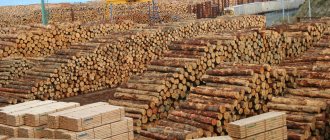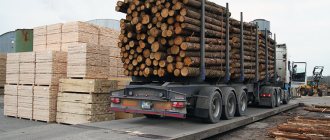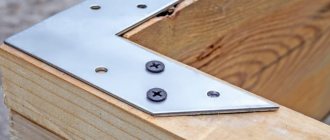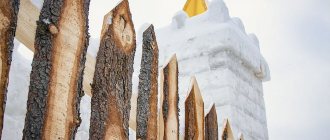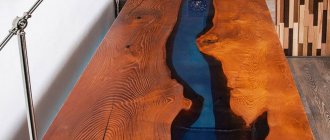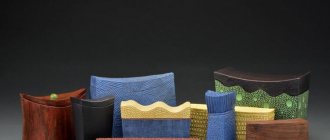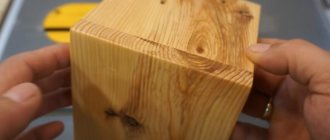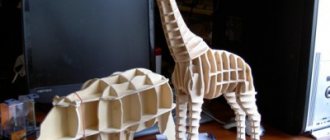Methods for bleaching wood at home: using available formulations
Often, when performing repair work or restoration of furniture, it becomes necessary to remove stains from the wooden surface, which can be caused by:
- the appearance of mold, which was subsequently removed, but the memory (in the form of local darkening of the surface) of its vital activity remained;
- natural aging of wood;
- contact with the wooden surface of various organic and inorganic dyes;
- the ingress of chemically aggressive substances that caused a change in the structure and natural color of the tree.
Whitening (lightening) solid wood and removing various stains from its surface can be done independently using:
- specialized chemical bleaches and antiseptics, which can be purchased at household chemical stores;
- self-prepared bleaching solutions according to folk recipes.
Caution when working with wood bleaches
It is necessary to avoid getting the substances on clothing, as bleached stains will immediately remain on the fabric. You should work in special clothing or clothing that you don’t mind throwing away. It is imperative to use goggles, a respirator, gloves, and ensure good ventilation in the room.
In case of contact with the skin, the area should be thoroughly rinsed with water; if the composition gets into the eyes, they should also be washed and consult a doctor immediately! Bleach should be stored in its original packaging in a dark place inaccessible to children and animals. All tools are washed with water after work.
Bleaching wood before painting with clear varnishes
Often, before covering wooden panels with colorless varnish, dark spots are discovered on them. Removal by grinding is not always possible either due to the deep penetration of the coloring substance into the wood layer or due to the undesirability of reducing the size.
If the size of the stains is small and their depth is insignificant, then quickly, without obtaining complex reagents, the wood can be bleached using a hot solution of oxalic acid.
To prepare a working solution, 2.0...6.0 grams of powdered acid are dissolved in 100.0 milliliters of hot water. If it is necessary to lighten plywood or a veneered product, then in order to avoid peeling of the decorative layer or splitting the layers of plywood sheets, the solution is cooled to room temperature.
The time it takes to impart the desired level of lightening to a wooden surface depends on the condition and type of wood. After the procedure is completed, the wood is dried and treated with a stabilizing solution in order to prevent the subsequent appearance of resinous discharge. The solution is prepared according to the following recipe:
- 3.0...5.0 grams of soda ash are dissolved in 100.0 milliliters of boiling water;
- after cooling the solution, 15.0 grams of sanitary “bleach” (bleach) is added to it;
- the resulting composition is treated several times, without intermediate drying, on a wooden surface;
- at the final stage, the surface is washed with clean water and dried.
You can quickly bleach the surface of wood using hydrogen peroxide and an aqueous solution of ammonia and ammonia. It is advisable to carry out all procedures outdoors or in a well-ventilated area. The proportions of ingredients depend on the wood species and are selected experimentally. After treatment with this composition, the surface does not require thorough washing and is ready for further processing immediately after drying. However, some species (for example, walnut) lose their natural color when stains are removed with this solution.
General information
Why do you need to bleach wood?
Unevenly painted and darkened wood begins to spoil the appearance of the coating or building. Usually, the very first sign of an emerging problem is blue spots, which gradually grow and merge with each other. If measures are not taken in time, black and even greenish stains will begin to appear - mold will actively multiply on the wood. Fungi that change the color of wood will not only worsen the aesthetics, but also harm the structure of the material. They make the wood more susceptible to the work of wood-destroying fungi, which are not at all easy to destroy.
Bleaching is an effective way to control microscopic organisms and is usually done for the following reasons:
- If the wood was not treated with a protective compound in time.
- To restore areas that are damaged.
- To hide small defects.
- To obtain a uniform color scheme for a coating made from different types of wood.
Bleaching can help with blackness, because all the products used are to some extent antiseptics and remove mold, biodamage, rotting, and darkening. Typically, bleaches are very effective against fungi, bacteria and insects. And yet, bleached wood will be etched only superficially - up to 0.5 cm, but most of the products do not penetrate inside at all, and therefore, to prevent blackening, it is better to start using fungicidal compounds in time.
Why does wood begin to change its original color?
Wood is an organic material that is very attractive to microbes, pests and fungi. Typically, the reproduction of such microscopic organisms begins if the humidity level rises and the air temperature becomes higher. In special cases, moss or lichen may even appear on the surface of a wood floor. Most often, black stains affect the wood of bathhouses, where conditions are ideal for the proliferation of fungal colonies.
It also happens that wood turns blue or black for other reasons:
- Logs and lumber were transported incorrectly.
- Violation of storage conditions.
- Precipitation on the surface of the wood.
- Long-term exposure to direct sunlight.
Mold and mildew can appear on absolutely any material, regardless of the type of wood. Even non-glued laminated timber, despite the chemical impregnation carried out at the factory, can harbor microbes, even on imitation timber! The color of the material can change in different ways, and the breed will make a big difference here. So, the oak gets a “gilding”, and the birch begins to turn blue in spots, the dark ash becomes completely lighter, and the walnut acquires a bright red color. You should learn how to bleach wood in the early stages of fungal infection, because otherwise it will not be possible to completely eliminate the problem.
Other whitening methods
Some home craftsmen, when performing bleaching, want to not only remove stains and dirt from wooden surfaces and update their appearance, but also strive for color changes, more texture and the creation of various effects. Let's consider the most widely available methods that are safe for home use.
To bleach hardwood products, while simultaneously emphasizing their texture, you can use lime milk. To prepare it, 10.0 grams of baking soda and 80.0 grams of bleach are dissolved in 350.0 milliliters of water. The resulting composition is kept in complete darkness for one and a half to two days. The solution loses its properties during storage and requires immediate use.
For accelerated lightening, it is fashionable to use the following recipe. In one liter of water, successively dissolve:
- 20.0 grams of sulfuric (battery) acid;
- 15.0 grams of oxalic acid powder;
- 25 grams of sodium peroxide (peroxide), which can be replaced with 10.0 grams of hydrogen peroxide.
- For shallow bleaching, you can prepare a mixture of 40.0 grams of potash and 150.0 grams of bleach, which are dissolved in 1.0 liter of water. With its help you can lighten fairly large areas of wooden surfaces. The solution is applied with a paint roller, and the degree of lightening is checked visually. When the desired effect is achieved, the surface is washed with water.
- For decolorization, you can use food grade acetic or citric acid, which is dissolved in an amount of 50.0 grams per 1.0 liter of water.
Industrial bleaches
Often, summer residents are faced with a problem when boards stored in the fall during the winter storage period have lost their color, become old and mold has appeared on them. This is especially unpleasant when it comes to planed boards intended for finishing and cladding “under varnish” or for the construction of gazebos. To restore their original appearance, the industry produces an excellent whitening and lightening agent “Neomid”, which has antiseptic properties.
It removes moldy “blue”, brightens the surface and prevents the reappearance of mold and fungi. After treatment with this composition, black blurs, spots and dots are removed from wooden surfaces, and the material itself acquires the appearance of freshly planed wood. Unlike other clarifiers, Neomid penetrates shallowly into the thickness of the wood, without thereby disturbing its structure. Detailed instructions for use are included with the drug upon purchase.
There are other wood bleaching technologies and substances designed to lighten its surface. Here are the most affordable ones that you can use without additional costs or loss of time.
When professionally processing wooden surfaces, quite toxic solutions are often used, which makes no sense to use for the restoration of one table or door panel.
The review describes in detail a special product for bleaching wood.
The best wood bleaches
Neomid 500
The market for goods related to wood processing offers a wide range of bleaches of different brands, domestic and foreign manufacturers.
Different brands of drugs differ in chemical composition and cost, packaging and options for use.
Neomid 500
Neomid 500 is a chemical composition used for bleaching and disinfection of wood. Used for treating wooden surfaces indoors and outdoors.
When bleaching with Neomid 500, the wood returns its natural color, thereby increasing its grade, the structure of the wood does not change, and its properties are preserved.
In addition, this bleach destroys fungal formations that destroy the structure and color of wood.
Neomid 500 is used as an antiseptic for processing pellets (fuel granules), which increases their shelf life.
Advantages of the drug:
- environmental Safety;
- high quality of goods;
- optimal price-quality ratio;
- ease of use;
- versatility of use depending on the type of wood being processed.
The product is certified and sold in cans of different packaging - 1.0/5.0/24.0/35.0 kg.
Manufacturer - group, Russia.
Senezh Effo
This bleach is used to lighten wooden surfaces that have lost their natural color when exposed to atmospheric conditions and fungal infections due to prolonged use and exposure to ultraviolet rays.
Senezh Effo is used to disinfect fungal infections of various stages on the surface of wooden products and finishing materials.
This preparation is used when processing planed and chopped lumber that has not previously been treated with paints and varnishes. Bleach can be used indoors and outdoors and should not be used to remove blue stains from inside wood grain.
Advantages of the drug:
- does not contain chlorine, based on an oxygen-transfer agent;
- provides deep whitening;
- does not lose its characteristics during long-term storage and freezing;
- does not form chemical burns on the treated surface;
- capable of removing all types of organic damage;
- safe for humans and animals when used as directed;
- has a pleasant lemon smell;
- is an explosion and fire safe substance.
Sold in various containers and packaging.
, Russia.
Homeenpoisto
Homeenpoisto is a hypochloride solution designed to remove mold from wooden surfaces. This product is used to clean painted and unpainted surfaces.
This is a jelly-like solution that contains sodium hypochlorite and sodium hydroxide, which are aggressive substances that require special care when working with them.
Sold in canisters of 1.0 and 5.0 liters.
, Finland.
Sagus
This product is an effective means for bleaching wood both indoors and outdoors. Sagus is used when processing chopped, sawn and planed wooden surfaces.
The solution removes darkening on the surface of wood of various origins (from external influences, under the influence of time), and also serves as a disinfectant that removes biological lesions (microorganisms, insect larvae).
The advantages of this drug are:
- possibility of bleaching inside the wood surface (deep penetration);
- high efficiency;
- retains its positive properties during long-term storage and freezing;
- does not cause chemical burns to the treated wood;
- capable of removing all possible types of damage to wooden surfaces;
- fire safe.
Sold in cans, packaged in 5.0 and 10.0 liters.
Manufacturer - group, Russia.
Fongifluid Alpa
Fongifluid Alpa is an aqueous solution based on fungicidal (antifungal and anti-mold) substances. The drug is intended to destroy various types of moss and lichen, as well as mold and microorganisms.
Used for external and internal work as a preventive and therapeutic agent.
Sold in cans of 0.5/2.0/5.0/20.0 liters.
, Russia – representative of the SOMEFOR® concern, France.
Wood bleaching: means and methods
So you have built your wooden house. You just want to admire it: the natural texture of the wood, the pleasant color - everything is new and fresh. Unfortunately, over the years, its appearance will deteriorate - sun rays, mold and “blue stain” will sooner or later cause the walls to change color.
Wood bleaching is a simple and reliable way to return the walls of your home to their original appearance. True, its effectiveness is determined by the depth of the lesion: if it exceeds 3 mm, the composition will not be able to penetrate inside.
Blue stain is a defect in wood, as a result of which it changes its color to blue-gray and bluish. The cause of the lesion is marsupial fungi. Blue stains do not affect the strength of the walls of the house, but greatly impair the aesthetic qualities. In addition, marsupial fungi can damage protective coatings, as a result of which the wood begins to rot.
Wood bleaches Neomid-500 and Sagus Profi
Over time, the wood often begins to darken: first, blue spots appear, then large black stains, on which mold actively multiplies. Bleach will help cope with this problem.
The best of them are Neomid-500 and Sagus Profi
NEOMID 500 is a bleaching and cleaning agent that destroys fungi, plaque and restores the natural color of wood. The product is produced by the Russian company EXPERTECOLOGY-NEOHIM. The product meets international chemical production standards.
Neomid-500 is used for preventive purposes or to lighten wood that has signs of fungal damage. It is applied not only to the darkened area, but to the entire surface to completely destroy the spores.
If the log is already affected, a concentrate and a substance diluted with water 1:1 will do. You can update the color with a 1:2 solution. The substance is applied in a thin, uniform layer. You must follow safety requirements: wear goggles and gloves. Contact of the substance with skin is unacceptable. After impregnation, the wood dries within 24 hours. The room must be ventilated. Permissible temperature – up to 20 °C.
Advantages of Neomid-500 bleach:
- the product returns the wood to its natural color 12 hours after use;
- a single preventive treatment protects the building from harmful microorganisms for 20 years;
- low consumption: approximately 150 g/m2.
YouTube video about Neomid-500:
Sagus Profi – bleach for wooden log houses
It acts in a similar way: it lightens the wood and removes the effects of moisture, mold and bioorganisms. It is acceptable to use it for processing concrete, tiles, stone and other materials that have been subjected to biodestruction. Sagus Profi has a chlorine base and a slight chlorine smell. In appearance it is a transparent liquid with a slight yellowish tint. It does not need to be diluted or washed off. Sagus is applied to a dry, unpainted surface. It is recommended to use a brush with hard synthetic bristles as a tool. Sometimes a repeat procedure is necessary. Consumption – 110-170 g/m2.
Advantages of Sagus Profi bleach:
- it is permissible to use it at negative temperatures;
- quick drying (the drying speed is affected by temperature and air humidity: at +20°C the product will dry in 2 hours);
- This is one of the few bleaches that can be used outdoors in winter.
Both bleaches are effective. Neomid-500 is more delicate and is suitable for the prevention and “refreshing” of wood. Sagus Pro is more intense, it will remove deep lesions faster.
Video on YouTube about Sagus Profi wood bleach with reviews and expert recommendations:
Expert woodworker: Kuznetsov Sergey Petrovich
Principle of wood bleaching
All wood bleaching products work on the same principle: they cause an oxidation process, as a result of which the pigment colors of lignin (a substance that characterizes the woody walls of plant cells) become discolored, and fungal cells are destroyed. Reactive oxygen radicals are responsible for whitening.
Bleaching compounds are divided into those containing chlorine and those not. The first contains: potassium hypochlorite, sodium hypochlorite, chlorine dioxide and bleach. In chlorine-free formulations, the active ingredients are: hydrogen peroxide, ammonia, salts, alkalis and oxalic acid.
Wood bleaches and purposes of their use
One of the chemical methods for treating darkened wood is bleaching. Wood bleach returns the original color of the material, helps lighten darkened areas, and destroys fungi, which prevents further darkening.
Bleaching agents that differ in their active ingredients will help lighten darkened elements:
- chlorine-containing, contain sodium or potassium hypochlorites, bleach and chlorine dioxide,
- preparations without chlorine - hydrogen peroxide, ammonia and oxalic acid.
Most bleaches have a disinfectant, fungicidal effect and can be used for preventive and protective purposes. Whitening wood helps improve the appearance of discolored areas.
Preparations for wood bleaching
Lightening of darkened surfaces is carried out using a wide range of preparations developed by the chemical industry.
A well-known preparation for lightening is Woodmaster Frost bleach. Its difference is that after processing a darkened area of wood, the natural color is restored and the pattern and structure of the wood is not damaged. In addition, it has protective properties and is used before painting or impregnating structures. Due to the gentle composition of the bleach, it is used indoors to improve the appearance of wood trim. Frost bleach, which is applied to a clean, dry surface with a brush and left to dry for 5-12 hours. Then it is recommended to wash the treated area with water. The active ingredient in bleach is an aqueous solution of sodium hypochlorite.
Belsin bleach contains chlorine-containing substances. It is applied with a brush, sponge or spray method; to achieve the desired degree of whitening, you can repeat the procedure. Belsin wood bleach is used for preventive, protective treatment of wooden elements if it is known in advance that they will lie in a damp place. The product can be easily applied to material of any moisture content. The composition of wood bleach makes it easy to wash away traces of use remaining on the surface with water.
Senezh is a line of antiseptics for preventive and protective treatment of wooden structures for various purposes. It is not recommended for use on surfaces previously treated with varnish, drying oil and other protective and water-repellent agents. Senezh penetrates deeply into wood, destroys and suppresses the development of mold fungi. The preparation is applied to the cleaned wood using brushes, rollers, or sprayers. Also suitable for soaking and deep impregnation processes in an autoclave, which improves protection and extends its life to 30-35 years.
Neomid 500 is a Russian bleaching impregnation for wooden structures. Restores the natural color of wood and provides protection against fungal damage for a long time. As a side effect of the treatment, salt is formed on the surface, which is easily removed with water. The concentration of the bleach solution depends on the purpose. To remove small stains and for preventive treatment, a 1:2 ratio of concentrate and water is sufficient. If the surface is damaged less than 3 mm, it is enough to dilute the impregnation with water one to one. For deep and extensive darkening of the surface, the use of undiluted concentrate is allowed.
Do-it-yourself wood bleaching
Faced with the problem of changing the color of the walls of the house, many decide to deal with it on their own. For this purpose, inexpensive and accessible wood bleaching liquids are used - hydrogen peroxide and oxalic acid.
Whitening wood with hydrogen peroxide is a simple and effective method. But it does not work on all types of wood. For example, peroxide does not bleach oak, but even changes its color. But it is ideal for bleaching birch, beech or walnut. The correct concentration of the chemical solution is at least 30%. Before application, the walls of the house are moistened with warm water and covered with a thin layer of ammonia (10%). After the bleaching procedure, it is necessary to clean the surface using a mixture of soda ash and bleach. For 15 grams of lime you need to take 3 grams of soda and 100 grams of water.
Bleaching with oxalic acid should be done with caution. The fact is that the desired effect can be achieved by mixing all the ingredients in the correct percentage. You will need a 10% oxalic acid solution and a 20% sodium hydrogen sulfate solution. First, sodium hydrogen sulfate is applied to the surface, then a solution of oxalic acid. After five minutes, the compositions must be washed off the surface with water.
Another way is to bleach wood white. However, when working with white, you must follow safety rules: wear gloves and protect your eyes.
“Rime” for bleaching wood is a more modern means that returns an attractive appearance to the walls of the house. To work with Iney, you must follow safety rules: dress in a protective suit, wear a mask or goggles, and rubber gloves.
Treating wood with bleach
Treatment of wooden surfaces with one or another type of bleach is carried out in accordance with the operating instructions that come with the specific type of preparation.
The instructions describe what needs to be done before application, how to apply the product and how long it will take for it to dry. In addition, there are general recommendations that can be used when treating wooden surfaces with bleaching agents, these are:
- When performing work, do not mix different brands of bleach.
- After the preparation has dried, the surface should be washed with clean water.
- If any area of the wooden surface is severely damaged, it is necessary to treat this area with a more concentrated solution of the drug.
- The work must be carried out under conditions corresponding to the mode of use recommended by the product manufacturer.
- When working with bleaches, you must read the instructions for use and follow safety precautions for working with substances of this kind. This applies to the use of personal protective equipment, as well as the provision of ventilation when performing work indoors.
Wood bleaches are effective preparations that allow you to extend the life of wooden products and give them a beautiful and natural appearance.
Whitening rules
As you understand, bleaching wood at home is not the easiest thing. However, if you decide to do this yourself, follow the rules.
- Whatever product you use, wash it off with water after application.
- If you use acidic bleach, wash it off with an aqueous solution of baking soda.
- You cannot combine different bleaching agents on the same surface.
- Do not bleach glued products; they may fall apart.
- Want to speed up the process? Treat the surface with a solution of sulfuric acid (20 grams), sodium peroxide (25 grams), oxalic acid (15 grams) and water (1000 grams).
Alternative method
You can do all of the above steps yourself or contact a professional. To bleach darkened wood, we use the composition Acrylit 153. It restores the natural color, effectively removes microorganisms, does not interfere with the “breathing” of the wood, does not destroy its structure, does not affect adhesion, strength, paintability and porosity, and does not change the smell.
Acrylit 153 is diluted with water in a ratio of one to one (in cases of severe damage to the wood, it is not diluted) and applied to the walls with a roller. If necessary, after 5 hours the procedure is repeated. The product is suitable for bleaching pine wood.
